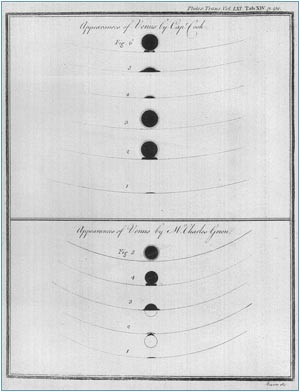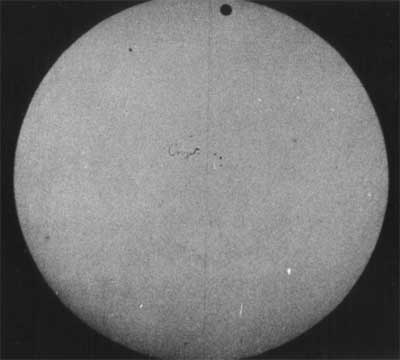The 2004 Transit of Venus
On June 8 2004 an event will occur that no living person has seen - the planet Venus will pass between the Earth and the Sun, appearing as a black disc on the face of the Sun. This rare astronomical event is called a transit. The last transit of Venus took place in 1882 and only six have occurred since the invention of the telescope. This year's transit starts at 3:07 pm in Brisbane and Sydney, a minute later in Canberra, Melbourne and Hobart, 2:38 pm in Adelaide, 2:39 pm in Darwin and 1:10 pm in Perth. It will continue through till sunset in Australia although observers elsewhere such as Europe can observe the entire transit.
First observed in 1639 by the brilliant young English astronomer, Jeremiah Horrocks, subsequent observations provided the first example of international collaboration for a scientific program. The aim of the program was to observe the transit from widely separated locations so that astronomers could ultimately calculate an accurate value for the distance between the Earth and the Sun. In 1769 Lieutenant James Cook sailed on HMS Endeavour to Tahiti in the South Pacific to observe the transit. Following the successful observation of the event he opened sealed orders instructing him to sail westward and chart new lands, resulting in European contact with New Zealand and the east coast of Australia.

The 1874 and 1882 Transits of Venus were both visible from Australia and resulted in extensive local and foreign observing programs being conducted from a number of sites in Australia. The only surviving photograph of the 1874 transit from Australia was taken by a large US expedition to Tasmania. Venus is the large black disc near the top of the Sun in the photograph below.

Transits of Venus occur in pairs, eight years apart with over a century before the next pair. This year's transit will be followed by one on 7 June 2012. After that the next pair will occur in 2117 and 2125.
The radio telescopes of the Australia Telescope National Facility do not directly observe the Sun, however the CSIRO Division of Radiophysics, from which ATNF developed, pioneered many techniques for observing the Sun at radio wavelengths. Early radio observations of the Sun were carried out from several locations including Dover Heights in Sydney's eastern suburbs. The current Australia Telescope Compact Array at Narrabri in north-western NSW is on the site of the Culgoora Radioheliograph that was built in the 1960s.
Caution
Looking at the Sun directly can cause serious eye damage or blindness. For details on how to observe the transit safely, read the Transit of Venus Factsheet prepared by the Astronomical Society of Australia or visit the websites below for safety instructions.
Where to Find Out More
The following websites provide detailed information on the 8 June 2004 Transit or associated events.
- CSIRO is providing a live webcast of the first few hours of the transit from Canberra. To view the webcast and find out more about the transit visit the CSIRO's Transit of Venus 2004 -Live Webcast site.
- Astronomical Society of Australia Transit of Venus Factsheet. This eight page pdf file has been prepared by the Astronomical Society of Australia and gives historical and observing details for the event. It provides timings for Australian capital cities and discusses safe observing techniques.
- Venus Transit 2004 is a large and detailed site produced by the European Southern Observatory, the European Association for Astronomy Education and the Paris Observatory. It provides a wealth of information including extensive educational material. This site is coordinating a global observational program where you can submit your observations to help determine the distance to the Sun.
- Transit of Venus: voyages in time and space is an extensive New Zealand website produced with the support of the Government and other institutions and groups. It has sections on the astronomy of the transit, Cook's exploration. Maori and Polynesian navigation and ocean voyaging as well as video and audio talks. It also has a link to the Exploratorium's live webcast of the transit from Athens, Greece on June 8.
- Transit of Venus - University of Central Lancashire. The first observations of a transit of Venus were made by the young English astronomer, Jeremiah Horrocks in 1639 from the village of Much Hoole, near the present university which today is very active in the field of solar studies. This site has a wealth of information on the history and science of the event plus downloads and links to live webcasts on the day.
- Transit of Venus is an extensive American site with a range of scientific, historical, educational and observing information.
- 2004 and 2012 Transits of Venus is a site by NASA's Goddard Space Flight Centre with details on the scientific observations for the transits plus an observer's handbook and global visibility information.
- Sydney Observatory: The Transit of Venus. Sydney Observatory is running a number of public and school events to celebrate the transit and is holding a special exhibition on it from June to December this year. Details on all their events can be found at this site.
- The National Trust are holding several special events at Woodford Academy in the Blue Mountains to mark the transit and view the historic Fairfax telescope used to observe the 1874 transit from the site.
